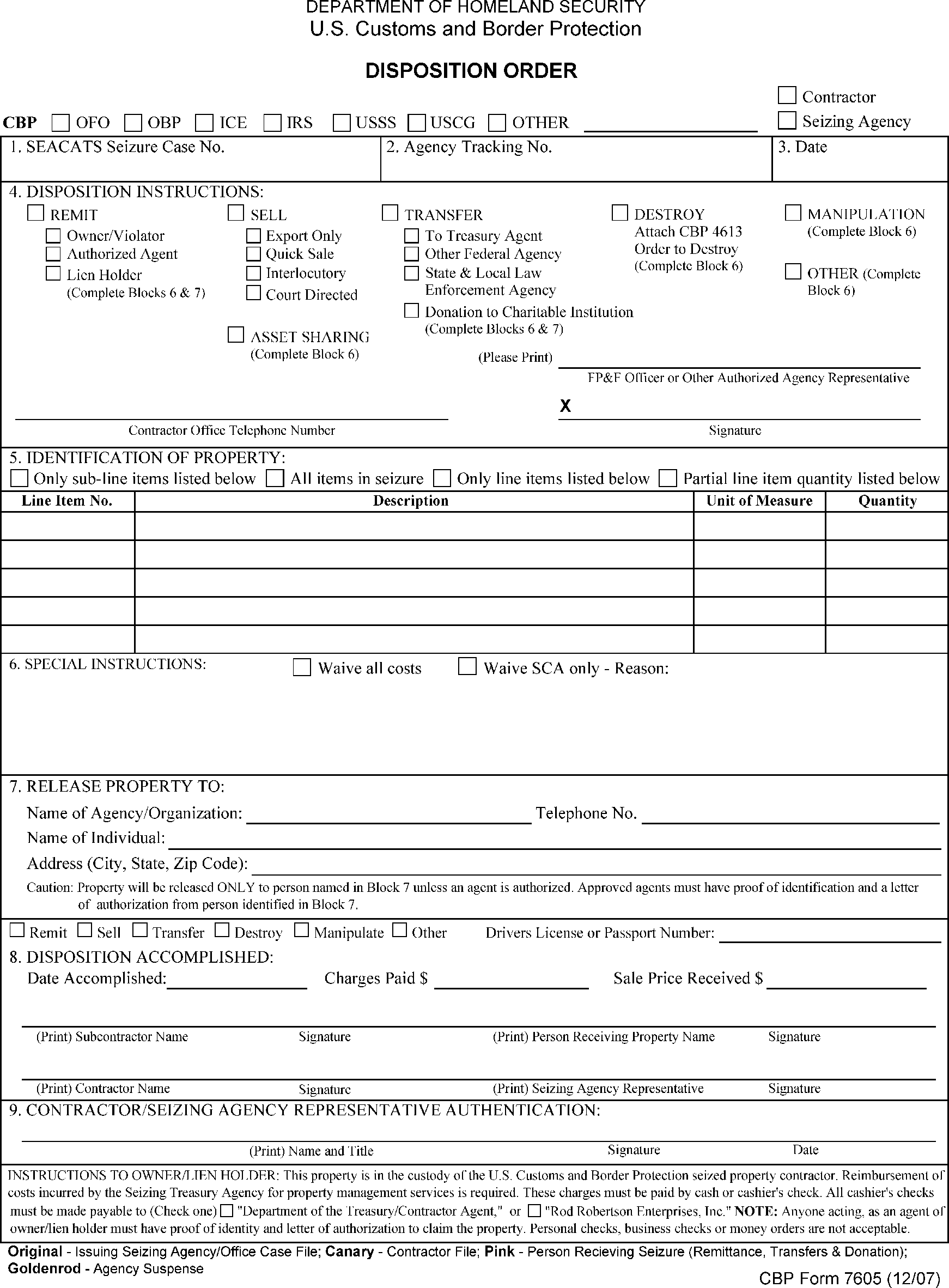- 9.7.6 Custody and Storage of Seized Assets
- 9.7.6.1 Program Scope and Objectives
- 9.7.6.1.1 Background
- 9.7.6.1.2 Authority
- 9.7.6.1.3 Roles and Responsibilities
- 9.7.6.1.4 Program Management and Review
- 9.7.6.1.5 Program Controls
- 9.7.6.1.6 Acronyms
- 9.7.6.1.7 Related Resources
- 9.7.6.2 Executing the Seizure
- 9.7.6.2.1 Seizure Warrant
- 9.7.6.2.2 Warrant of Arrest In Rem
- 9.7.6.2.3 Preliminary Order of Forfeiture
- 9.7.6.3 Use of Property Under Seizure
- 9.7.6.4 Custody and Storage of Assets Seized Pursuant to Title 18
- 9.7.6.5 Seized Property Management Contracts
- 9.7.6.6 Seized Property Contractor Operations
- 9.7.6.6.1 Communications with the Seized Property Contractor
- 9.7.6.6.2 Availability of the Seized Property Contractor
- 9.7.6.6.3 Contractor Operated Facilities
- 9.7.6.6.4 Vendors and Subcontractors
- 9.7.6.7 Seized Property Management
- 9.7.6.7.1 Disposition Orders
- 9.7.6.7.2 Consignment of Seized Property
- 9.7.6.7.3 Receipt and Transfer of Seized Property
- 9.7.6.7.4 Documentation of Condition of Seized Property
- 9.7.6.7.5 Transportation of Seized Property
- 9.7.6.7.6 Types of Custody
- 9.7.6.8 Appraisal
- 9.7.6.8.1 Appraised Value
- 9.7.6.8.2 Fair Market Value
- 9.7.6.9 Storage and Accountability of Property
- 9.7.6.9.1 Facilities
- 9.7.6.9.2 Methods of Storage
- 9.7.6.9.3 Vehicle, Vessel, and Aircraft Storage
- 9.7.6.9.4 General Property Storage
- 9.7.6.10 Real Property
- 9.7.6.10.1 Seized Real Property Services
- 9.7.6.10.2 Pre-Seizure Analysis
- 9.7.6.10.3 Post and Walk
- 9.7.6.10.4 Headquarters Approval to Seize Real Property and Businesses
- 9.7.6.10.5 Initial Services upon Transfer of Real Property to the Seized Property Contractor
- 9.7.6.10.6 Appraisal and Title Search/Report
- 9.7.6.10.7 Security
- 9.7.6.10.8 Operation of Commercial Businesses
- 9.7.6.10.9 Occupancy Issues and Eviction from Real Property
- 9.7.6.10.10 Management and Rental
- 9.7.6.11 Physical Accountability
- 9.7.6.11.1 Access to Seized Property
- 9.7.6.12 Maintenance
- 9.7.6.12.1 Conveyance Maintenance
- 9.7.6.12.2 General Property Maintenance
- 9.7.6.12.3 Repair, Refurbishment, Rehabilitation, and Modification/Upgrade
- 9.7.6.13 Risk Management
- 9.7.6.13.1 Litigation and Court Orders
- 9.7.6.13.2 Control of Hazard Materials
- 9.7.6.13.3 Adverse Incidents
- 9.7.6.14 Storage of Seized Currency, Financial Accounts, and Financial Instruments
- 9.7.6.14.1 Currency
- 9.7.6.14.2 Financial Accounts
- 9.7.6.14.3 Financial Instruments
- 9.7.6.14.4 Digital Assets
- 9.7.6.15 Procedures for the Deposit/Transfer of Seized Funds to the Treasury Suspense Account
- 9.7.6.15.1 Wire Transfer Deposits
- 9.7.6.15.2 Interagency Payments and Collections Deposits/Transfers
- 9.7.6.15.3 Deposit Reporting Requirements
- 9.7.6.15.4 Delivery of Seized Funds to Treasury Executive Office for Asset Forfeiture
- Exhibit 9.7.6-1 Department of Treasury Process Receipt and Return
- Exhibit 9.7.6-2 Disposition Order
- Exhibit 9.7.6-3 Post Forfeiture Occupancy Agreement
- Exhibit 9.7.6-4 Occupancy Agreement
- Exhibit 9.7.6-5 Letter - Notice to Vacate (Defendant)
- Exhibit 9.7.6-6 Instructions for Transfer of Funds to the Treasury Suspense Account
- Exhibit 9.7.6-7 TEOAF Form #6, Deposit Information
- Exhibit 9.7.6-8 Letter - Notice to Vacate (Tenant)
- 9.7.6.1 Program Scope and Objectives
Part 9. Criminal Investigation
Chapter 7. Asset Seizure and Forfeiture
Section 6. Custody and Storage of Seized Assets
9.7.6 Custody and Storage of Seized Assets
Manual Transmittal
July 24, 2024
Purpose
(1) This transmits revised IRM 9.7.6, Custody and Storage of Seized Assets.
Material Changes
(1) Added Internal Controls to be compliant with IRM 1.11.2.2.4, Address Management and Internal Controls and IRM 1.4.2, Resource Guide for Managers Monitoring and Improving Internal Controls.
(2) Added “or qualified federal personnel” after AFC throughout the IRM.
(3) Updated “Warrants and Forfeitures” to “Asset Recovery & Investigative Services” throughout the IRM.
(4) Subsection 9.7.6.2(3)(a) removed “see Treasury Directive 24 - Post and Walk in Light of the Supreme Court Decision in United States v. James Daniel Good Real Property for additional guidance.” and added “See Treasury Directive Number 3 for additional guidance.”
(5) Subsection 9.7.6.2(3)(b) removed “see Treasury Directive 24 - Post and Walk in Light of the Supreme Court Decision in United States v. James Daniel Good Real Property for additional guidance.”
(6) Subsection 9.7.6.6(3) added “However, upon request, the seized property contractor will provide required storage space for firearms.” and updated IRM reference to IRM 9.7.6.9.6.
(7) Subsection 9.7.6.6(4) added “Note: The Treasury Forfeiture Program will no longer allow tangible property to be directly shared with or transferred to state and local law enforcement agencies. This includes but is not limited to vehicles, vessels, computers, electronic equipment, and real property.”
(8) Removed subsection 9.7.6.6.6(5).
(9) Subsection 9.7.6.9.3(4) removed “in Document Manager” and added “on the ARIS SharePoint site”.
(10) Added Subsection 9.7.6.9.3(5)(d) “name and address of owner/carrier/consignee”.
(11) Subsection 9.7.6.9.6(d) added “Custody Receipt for Retained or Seized Property”.
(12) Subsection 9.7.6.10.1(3)(b) added “should be appraised prior to transferring to property contractor”.
(13) Subsection 9.7.6.12.9(5) updated “Eviction Letter” to “Letter - Notice to Vacate (Defendant) and/or Exhibit 9.7.6-8 Letter- Notice to Vacate (Tenant).”
(14) Subsection 9.7.6.15.1(1) added “with copies of all litigation documents and court orders immediately upon receipt, but no later than specified in the SOW. The AFC, or qualified federal personnel, will provide “.
(15) Updated entire subsection 9.7.6.16.4 to current procedures.
(16) Subsection 9.7.6.17 removed the note.
(17) Subsection 9.7.6.17.4(2) updated physical address.
(18) Updated Exhibit 9.7.6-2 to current form.
(19) Updated Exhibit 9.7.6-4 to current document.
(20) Updated Exhibit 9.7.6-5 to current memo.
(21) Updated Exhibit 9.7.6-6 to current document.
(22) Updated Exhibit 9.7.6-7 to current document.
(23) Updated Exhibit 9.7.6-8 to current memo.
(24) Additional revisions, deletions, and grammatical changes are made throughout the section, which did not result in substantive changes but contributed to procedural clarity of the subject matter.
Effect on Other Documents
This IRM supersedes IRM 9.7.6 dated March 01, 2013.Audience
Criminal Investigation (CI)Effective Date
(07-24-2024)
Shea C. Jones
Acting Deputy Chief, Criminal Investigation
for
Guy A. Ficco
Chief, Criminal Investigation
-
Purpose: This section covers the transfer of custody and storage of property seized pursuant to Title 18 only:
-
For the custody and storage of property seized as evidence and for forfeiture pursuant to Title 26, see IRM 9.7.12, Evidence Seizures and IRM 9.7.13, Title 26 Seizures for Forfeiture,
-
For the disposition of property seized and/or forfeited under Title 18, see IRM 9.7.8, Disposition of Seized and Forfeited Property.
-
-
Audience: All CI employees.
-
Policy Owner: Director, Asset Recovery & Investigative Services (ARIS).
-
Program Owner: Director, Asset Recovery & Investigative Services (ARIS).
-
Primary Stakeholders: All CI employees.
-
Contact Information: To make changes to this IRM section contact CIHQIRM@ci.irs.gov.
-
Management of seized and forfeited property is an important component of the seizure and forfeiture program.
-
With proper pre-seizure planning, problems with custody and storage of seized property will be limited (see IRM 9.7.4, Pre-Seizure Planning).
-
See IRM 9.1.2, Authority for the delegated authority relating to IRM 9.7.6, Custody and Storage of Seized Assets.
-
The Director, Asset Recovery & Investigative Services is responsible for developing, maintaining, and overseeing this IRM and ensuring compliance with current policies and procedures.
-
The Director, Asset Recovery & Investigative Services will:
-
Review the IRM annually.
-
Update the IRM when content is no longer accurate and reliable to ensure employees correctly complete their work assignments.
-
Incorporate all permanent interim content into the next version of the IRM section prior to the expiration date.
-
-
The Director, Asset Recovery & Investigative Services will review the instructions and guidelines relating to the administration of Criminal Investigation’s asset forfeiture program for procedural, operational, and editorial changes.
-
The table lists commonly used acronyms and their definitions:
Acronym Definition AFC Asset Forfeiture Coordinator APV Appraised Value ARIS Asset Recovery & Investigative Services AUSA Assistant United States Attorney CAU Complex Assets Unit CBP Customs Border Protection CI Criminal Investigation CIS Computer Investigative Specialist COF Contractor Operated Facility COR Contracting Officers Representative Fed.R.Crim.P Federal Rules of Criminal Procedure FMV Fair Market Value IPAC Interagency Payments and Collections IRM Internal Revenue Manual DOJ Department of Justice NADA National Automotive Dealers Association SAC Special Agent in Charge SME Subject Matter Expert SEACATS Seizure Case and Asset Tracking System SOW Statement of Work TEOAF Treasury Executive Office for Asset Forfeiture TFF Treasury Forfeiture Fund USAO United States Attorney's Office USMS United States Marshals Service
-
In a civil forfeiture action, property subject to forfeiture is generally taken into custody pursuant to a seizure warrant, or a warrant of arrest in rem in a civil judicial forfeiture action where the property was not previously seized. In a criminal forfeiture action, property subject to forfeiture may be seized pursuant to a criminal seizure warrant, or upon entry of a preliminary order of forfeiture.
-
Upon execution of a seizure warrant, the seizing agent will give the person from whom or from whose premises the property was taken, a copy of the seizure warrant and a receipt for the property taken or leave the copy and receipt at the place from which the property was taken.
-
An inventory shall be made in the presence of the person from whose possession or premises the property was taken, or in the presence of at least one credible person other than the seizing agent and shall be verified by the seizing agent.
-
-
The return of a seizure warrant to a Federal magistrate shall be made promptly and shall be accompanied by a written inventory of any property taken.
-
The US Attorney's office should prepare the warrant of arrest in rem pursuant to which property will formally be brought within the control of the court. The warrant should set forth the date of the filing of the forfeiture action and should notify the recipient of the requirement that a claim be filed within 10 days and an answer within 20 days thereafter. It should also command the Treasury agent to arrest the property.
-
Pre-arrest planning is critical to the successful forfeiture of properties. Accordingly, Treasury law enforcement agencies shall ensure to the greatest degree possible, that all aspects of pre-arrest analysis are undertaken and fully discussed with the Assistant United States Attorney (AUSA). Activities include, but are not limited to, identity of all persons with an interest in the property, net equity, liens, mortgages, outstanding taxes, appraisals, hazard or toxic waste on property, title reports, IRS tax liens, estimated property management costs, estimated disposal costs, livestock, historically significant properties, occupants, tenants, inspections, inventory, writs of entry, contents and appurtenances, need for security-new locks, alarm systems, anticipation that violence or resistance will be encountered in executing the warrant, etc.
Note:
The seized property contractor: may perform all the services available to Treasury law enforcement agencies for pre-seizure activities (e.g., appraisals, inventory, photographing, title, and lien searches, etc.). The contractor is not authorized to conduct the "arresting" of property(ies). The "arresting" shall be conducted by the Treasury law enforcement agency.
-
Execution of Process: The Treasury agent arrests the property by serving the possessor with the warrant of arrest in rem and a copy of the complaint by attaching a copy of the documentation to the property. Service on other identified parties may be served by sending the same documentation to them via certified, return receipt mail. Whether the Treasury agent will have actual custody depends on several factors governed by case law in the judicial circuit. The AUSA must be consulted in the decision as to whether to take custody of the property. The general rules are as follows:
-
Tangible Property and Real Estate:
If possible, the Treasury agent must take actual custody of tangible property. When real estate is the subject of the forfeiture action, the Treasury agent is to take constructive possession by affixing a copy of the warrant of arrest in rem to a conspicuous place on the property and serving a copy of the complaint and process on the person in possession or the agent, see Treasury Directive Number 3 for additional guidance.
The execution of an arrest in rem does not provide for entrance into structures or otherwise onto properties without a writ of entry or a right of entry. The executing officers may enter upon the property to "post" the complaint and warrant but may not otherwise venture upon or into the property. The investigating officers should discuss fully the merits and needs of requiring a writ of entry or right of entry with the appropriate AUSA prior to securing the warrant of arrest in rem. If a district court magistrate or judge concurs, a writ of entry may be authorized to conduct an inventory and inspection of a dwelling, or some other pertinent activity. A writ of entry does not authorize a search for contraband or other evidence of criminal activity. The court may provide for a right of entry, which is contained in the warrant in rem. Whether a right of entry or a writ of entry is provided, the specific allowable activities for which the entry is granted shall be enumerated in the order. -
Intangible Property:
If intangible property is the subject of the forfeiture action, the Treasury agent executes process by providing a copy of the complaint and warrant of arrest in rem with the custodian.
-
-
Unless otherwise instructed by the responsible AUSA, the return of service of the warrant shall be made to the AUSA within 3 days of the execution of the warrant of arrest in rem on the Department of the Treasury Process Receipt and Return form (see Exhibit 9.7.6-1).
Note:
The US Attorney's office is required to prepare all legal notices regarding the property subject to forfeiture by virtue of a warrant of arrest in rem. Since the Treasury agency is responsible for the disposition of the asset, it is in Treasury's best interest to determine whether the notice requirements have been met to avoid disposition problems associated with unknown claimants, which may lead to title transfer problems. The Departments of the Treasury and Justice have an existing agreement to refund to the Department of Justice (DOJ) costs for these services. In those situations where the Office of the US Attorney will not undertake the notice requirements, the Treasury law enforcement agency is authorized to serve and publish notice as may be required with funding provided by the Treasury Forfeiture Fund.
-
Rule 32.2, Criminal Forfeiture, of the Federal Rules of Criminal Procedure (Fed. R. Crim. P.) authorizes the seizure of specific property subject to forfeiture upon entry of a preliminary order of forfeiture. The seizing agent will give the person from whom, or from whose premises, the property was taken a copy of the preliminary order of forfeiture or will leave the copy at the place from which the property was taken.
-
Property under seizure and pending forfeiture shall not be used for any reason, including official use, until such time as the final decree or court order of forfeiture is issued - exceptions must be granted by Treasury Executive Office for Asset Forfeiture (TEOAF) (see TEOAF Directive Number 8, Use of Property Under Seizure).
-
Absent the final decree or court order of forfeiture of property under seizure, the United States does not have title to the property.
-
Any use of property under seizure and pending forfeiture raises issues of liability and creates the appearance of impropriety.
-
-
All property seized for forfeiture pursuant to 18 USC 981 or 982, except as described below, will be transferred to the custody of the seized property contractor for storage.
-
The seized property contractor will take custody of all types of seized property except currency, virtual currency, and/or monetary instruments, controlled substances (drugs/narcotics, firearms, Class A and B explosives), and those instances when CI determines that storing the property in another location will be in the agency's best interest.
-
The custody of firearms will not be transferred to the seized property contractor. However, upon request, the seized property contractor will provide required storage space for firearms. The seized property contractor will maintain administrative custody only (see subsection 9.7.6.9.6, Types of Custody).
-
In addition to the types of property listed above, the seized property contractor will not take custody of property seized for forfeiture pursuant to:
-
Title 26,
-
Property seized and held as evidence,
-
Abandoned property.
-
-
There also may be situations, such as where at the request of the US Attorney's Office or when adhering to policy of a particular judicial district, CI may choose to manage or dispose of seized property.
-
When seized computer equipment is subject to forfeiture and is found to contain stored data which may be needed for evidentiary purposes, it should remain in the custody of a Computer Investigative Specialist (CIS) until the criminal investigation is completed.
-
There are two separate seized property management contracts, one for personal property and another for real property.
-
The Statement of Work (SOW) is the part of a federal contract that clearly and completely describes the contractor's work requirements. Excerpts taken from the seized property management services SOW, and its appendices, can be found in this IRM. The manual follows closely the format of the SOW, which should be referred to as needed for additional or more detailed information. The SOW is periodically updated to reflect the most current requirements. The Asset Forfeiture Coordinator (AFC), or qualified federal personnel, who are trained and certified as a field Contracting Officer's Representative (COR) will maintain a current copy of the SOW.
-
The seized property management contracts provide for services throughout the 50 United States and the District of Columbia, as well as Puerto Rico, all US territories and international seizures of real property. The real property contractor will provide pre-seizure services when requested.
-
The AFC, or qualified federal personnel, are the local CI representatives authorized to communicate with and task the seized property contractor to perform stated seized property management services and all arrangements for the transfer of seized property to the property contractor. The AFC, or qualified federal personnel, should be aware of and/or approve any contact between the seized property contractor and the asset forfeiture support services contractor or any other CI contact.
-
The ARIS Section will communicate and deal directly with the seized property contractor.
-
The seized property contractor is required to be available to provide stated seized property management services 24 hours a day, 365 days a year. The seized property contractor will provide telephone numbers to the AFC, or qualified federal personnel, to use to reach its offices 24 hours a day, including nights, weekends, and holidays.
-
The seized property contractor will keep the AFC, or qualified federal personnel, informed on how to contact appropriate representatives for off hours pick-up of vehicles, vessels, aircraft, etc.
-
A seized property contractor operated facility (COF) is a facility located in a high-volume workload area which has been designated to store, maintain, and dispose of seized property. It may also function as a sales center.
-
The seized property contractor will be responsive to AFC, or qualified federal personnel, requests to have seized property placed in appropriate storage facilities.
-
Based on frequent changes in workload, the seized property contractor will locate, evaluate, and solicit subcontractors and vendors on a continuous basis to supplement the seized property contractor's capabilities to manage and store property.
-
The seized property contractor is required to adhere to established subcontracting guidelines and ensure, on a continuing basis, that all property management service subcontractors and vendors maintain insurance adequate to protect the value of the seized property in accordance with the seized property contract.
-
The seized property contractor will take custody of all seized property, at/or in the vicinity of the place of seizure, or at any other location designated by CI.
-
The AFC, or qualified federal personnel, will make any decisions related to the management of any seized or forfeited property which is in the seized property contractor's custody as outlined throughout the SOW.
-
A Disposition Order (see Exhibit 9.7.6-2) is used to instruct or task the seized property contractor to perform stated seized property management services. The AFC and qualified federal personnel are the only authorized CI contacts to sign disposition orders.
-
Disposition orders may be sent to the seized property contractor by facsimile (fax) or e-mail; however, the original order must be sent to the contractor. The original document may not be required where the seized property contractor allows a statement to be included in the disposition order instructing the seized property contractor to use the faxed disposition order or emailed disposition order as the original.
-
The original disposition order will be signed by the seized property contractor upon completion of any property management services and returned to the AFC or qualified federal personnel.
-
In the event of a pending seizure, the AFC, or qualified federal personnel, will notify the seized property contractor as far in advance as possible and will prepare a disposition order and consignment order requesting the pick-up of any seized property.
-
The seized property contractor will respond to a request for transfer of property from the AFC, or qualified federal personnel, within the time period specified in the SOW unless another date and time is mutually agreed upon.
-
Seized property will be transferred to the seized property contractor at a designated site or site of mutual agreement. The seized property contractor will inspect and accept custody of property associated with each consignment.
-
The seized property contractor will conduct a joint inventory of seized property with the AFC, qualified federal personnel, or designated CI contact at the time of transfer.
-
Accessories, equipment, and spare parts required for the operation and/or maintenance of the seized property are normally included in the seizure of the property. Criminal Investigation should remove all other contents such as personal effects for return to the owner before the seized property contractor assumes custody of the seized property.
-
A properly completed and executed Form 9573, Custody Receipt for Retained or Seized Property and Form 9572, Custody Receipt for Retained or Seized Property - Continuation Sheet, are required for all seized real and personal property transferred to the custody of the seized property contractor. Form 9573 serves as the chain of custody form. Form 181, Property Inventory Record, must be completed, copied and the original provided to the seized property contractor when transferring custody of a conveyance to the seized property contractor. All of these forms are available on the ARIS SharePoint site.
-
At a minimum, the following information will be entered on the Form 9573 when transferring custody of seized property:
-
AFTRAK number (if assigned),
-
CIMIS number,
-
Date Seized,
-
Name and address of owner/carrier/consignee,
-
Seizing officer,
-
Telephone number,
-
Property line-item number,
-
Seized property description,
-
Condition and appraised value,
-
Date of transfer of custody name, title, organization, and signature of the persons transferring and accepting custody of the seized property,
-
Item and number of units transferred.
-
-
The seized property contractor will verify the Form 9573 for accuracy and completeness before or during acceptance of seized property.
-
The seized property contractor will not add anything or write on the Form 9573 except:
-
His/her signature and quantity on the signature line,
-
Annotate discrepancies,
-
Annotate that the seized property contractor accepts conditional, administrative and/or constructive custody as applicable pending inventory.
-
-
The seized property contractor will keep the original Forms 9573 and 9572. The original Form 9573 will be returned to the AFC, or qualified federal personnel, upon disposition of the seized property (see IRM 9.7.8, Disposition of Seized and Forfeited Property).
-
A completed property Form 181 is required for all seized vehicles, vessels, and aircraft transferred to the custody of the seized property contractor.
-
The seized property contractor will verify the Form 181 for accuracy and note if there are any discrepancies at this time.
-
The seized property contractor will keep the original Form 181.
-
The seized property contractor will also complete its own forms upon the receipt and transfer of any seized property. The AFC, qualified federal personnel, or other designated CI contact on site, will verify the accuracy of the information contained on the seized property contractor's forms before signing them.
-
The seized property contractor will provide the AFC, or qualified federal personnel, with the Seizure Case and Asset Tracking System (SEACATS) generated seizure number used to track and identify seized property by the seized property contractor.
-
Any movement of seized property from its current physical storage location must be approved by the AFC or qualified federal personnel. The seized property contractor will provide the Form 9573, which shows the new location of the seized property. The seized property contractor, or its designated agent, may contact the AFC, or qualified federal personnel, to confirm details of the proposed transfer.
-
At the time of the receipt and/or transfer of the seized property, it is the responsibility of the seized property contractor to document the condition of the seized property in writing, videos, and/or photographs.
-
The AFC, qualified federal personnel, or other designated CI contact on site, will also document the condition of the seized property in writing and may photograph or videotape the property.
-
The seized property contractor will arrange for the safe, secure, and cost-effective transportation of seized property from point of acceptance to an approved storage site.
-
While the common method of transfer is for the seized property contractor's agent/vendor/subcontractor to physically assume custody at the location designated by the AFC, or qualified federal personnel, alternate methods may also be agreed upon. For example, seized property which has been designated for transfer to the seized property contractor and can be packaged and shipped via US Mail, United Postal Service, or other responsible delivery service, can be so handled when the seized property contractor and the AFC, or qualified federal personnel, have determined this procedure to be the most cost-effective.
-
The seized property contractor will perform necessary emergency repairs to facilitate movement and storage of seized property in accordance with the threshold levels established in the SOW.
-
There are four types of custody for property:
-
Regular Custody: The seized property contractor will take physical possession of property, provide secure storage for property, perform necessary maintenance on property, control access to property, and dispose of property as instructed by the AFC, or qualified federal personnel.
-
Treasury Agency Custody: Criminal Investigation retains physical custody of property.
-
Administrative Custody: The seized property contractor will provide secured space for sensitive property. Criminal Investigation strictly controls access to this space.
-
Custody Pending Inventory: When directed by CI, the seized property contractor will take custody of certain property without conducting an inventory until CI arranges for a joint inventory at a later date. This must be documented on the Custody Receipt for Retained or Seized Property - Form 9573.
-
-
All seized property must be assigned a value upon seizure. The terms appraised value and fair market value have different meanings in the context of dealing with the seized property contractor.
-
The appraised value (APV) of seized property is the responsibility of CI. The AFC, qualified federal personnel, or other designated CI contact on site, will enter the APV for each line item on the Form 9573. The seized property contractor will notify the AFC, or qualified federal personnel, within the time period specified in the SOW when an APV was not provided on the Form 9573.
-
In situations where a third-party appraisal is required, the AFC, or qualified federal personnel, may request the assistance of the seized property contractor in obtaining third-party appraisals. The third-party appraisal becomes the APV.
-
The following types of seized property may require third-party appraisals:
-
Conveyances for which there are no established retail value publications, such as an antique,
-
High-value or specialty jewelry items should be appraised prior to transferring to property contractor,
-
Precious metals, stones, and gems,
-
Rare or valuable coins,
-
Objects of art,
-
Antiques or artifacts,
-
Any other unusual, unique, or special items.
-
-
Fair market value (FMV) is defined as the value of property or merchandise in a given market at which both buyers and sellers are willing to do business.
-
The seized property contractor will establish a FMV for seized conveyances within the time period specified in the SOW after the property has been transferred to the seized property contractor. The seized property contractor will establish a FMV for seized general property at the time it is designated for sale.
-
The seized property contractor will determine the FMV of conveyances by using wholesale value publications such as:
-
National Automotive Dealers Association (NADA) Official Use Car Guide,
-
Aircraft Bluebook Price Digest,
-
NADA Large Boat Appraisal Guide,
-
NADA Small Boat Appraisal Guide.
-
-
The seized property contractor will also use past sales experience, local merchants, trade catalogs, publications, manufacturers, or other persons with knowledge, and/or the internet to establish the FMV of seized property.
-
The seized property contractor will adjust the FMV of seized conveyances annually or immediately prior to the sale of the property, as is necessary.
-
The facilities and methods of storage utilized by the seized property contractor, including those necessary for vehicles, vessels, aircraft, and general property, vary according to need.
-
The seized property contractor can acquire storage facilities through lease, subcontract, purchase order, or other contractual arrangements. The seized property contractor is able to provide temporary, short-, or long-term storage throughout the 50 United States and the District of Columbia, as well as Puerto Rico and all US territories.
-
The seized property contractor may use all established Contractor Operated Facilities (COF). The current COF leases contain a provision that all lease agreements can be assigned to a successor prime contractor. The seized property contractor will subcontract for the most cost-effective facilities that meet stated requirements at all times. If the subcontractors and/or vendors are outside a particular field office location, the seized property contractor will obtain the AFC's approval before using the vendor. Any property stored outside of the field office location will be clearly identified as such by the seized property contractor.
-
Government or municipally owned facilities (Federal, state, or local) may be available at little or no cost, especially for conducting sales.
-
Seized property will be stored by the seized property contractor in the most cost-effective method available to preclude any deterioration of the property so that the physical condition of the property is maintained as it was at the time of acceptance. Methods of storage will range from open storage to highly secured facilities, depending upon the type of seized property to be stored.
-
Depending on geographical area and giving consideration to climate, security and other variable factors such as value, rarity, etc., some vehicles may require inside storage.
-
Water is the primary cause for the deterioration of certain vessels. Salt water significantly increases the deterioration. For vessels in short- or long-term storage that are stored in water, the maintenance and deterioration costs may be more than the cost of removing the vessel from the water and storing the vessel on land. The seized property contractor will determine the most cost-effective type of storage on a case-by-case basis. The decision will be based on vessel size, appraised value, and condition at the time of seizure.
-
Humidity in the air is a major cause for the deterioration of aircraft. The storage of aircraft near large bodies of salt water significantly increases this deterioration. The short- and long-term storage of aircraft in non-humid environments minimizes deterioration and is preferred when costs of transportation to such sites are not prohibitive.
-
The following subsections cover the real property management services under the real property contract.
-
The seized property contractor will provide assistance and property management services for seized real property for both residential and commercial properties such as dwellings, buildings, farms, businesses, and associated physical items and mechanical systems. Such seizures are non-routine, handled on a case-by-case basis, and may involve assistance on the day of seizure, post-seizure management, and disposition. Pre-seizure planning is essential when seizing real properties.
-
The seized property contractor will provide, or obtain from licensed professionals when requested by the AFC, or qualified federal personnel, the following specific services:
-
Pre-seizure analysis,
-
Initial services upon transfer of real property to the seized property contractor,
-
Appraisal (internet appraisals for initial cost-benefit analyses, appraisals from a licensed real estate appraiser at a subsequent time determined by the AFC),
-
Title search and report (licensed),
-
Security,
-
Maintenance, improvements, and cost to remedial lead-based paint and other hazard substance contamination as tasked by the AFC, or qualified federal personnel,
-
Operation of commercial businesses,
-
Management and rental,
-
Disposition/sale of real property.
-
-
Pre-seizure services available from the seized property contractor are covered in IRM 9.7.4, Pre-Seizure Planning.
-
The seized property contractor is not authorized to conduct or perform the arresting or post and walk of real or personal property. The arresting must be conducted by CI or other Treasury law enforcement agency.
-
Upon receipt of a Disposition Order from the AFC, or qualified federal personnel, which requires the contractor to make entry into the property, the seized property contractor will contact AFC or other designated CI contact regarding arrangements for the location, date, and time of the scheduled entry with CI presence.
-
The AFC, qualified federal personnel, or designated CI contact on site will have in their possession the court order that authorized entry (writ of entry) to the property and the requirements of the court. The seized property contractor will not enter the property unless accompanied by a representative from CI. The seized property contractor will provide specific services requested via Disposition Order issued by the AFC, or qualified federal personnel, and accompanied by the court order. These services may include but are not limited to:
-
Obtaining a title search and report,
-
Photographing and video filming,
-
Inventory of the property and contents,
-
Appraisal of the property,
-
Monitoring and oversight of the posted property by drive-by,
-
Evaluating and/or monitoring operating businesses by performing such functions as conducting stock inventories and auditing operation and financial records,
-
Other SOW services directed by the court through CI,
-
Identification of residential properties and/or building structures for lead-based paint.
-
-
Headquarters concurrence is required before real property and businesses are seized by CI and transferred to the seized property contractor. For specific procedures to obtain HQ approval to seize real property and businesses, see IRM 9.7.4, Pre-Seizure Planning.
-
The seized property contractor will be provided the following documents from CI before transfer of custody of a real property seizure:
-
A copy of the warrant or court order which states the seized property contractor is authorized to enter the property for management and disposal purposes,
-
Writ of entry, if applicable.
-
-
Upon transfer of custody of a real property seizure to the seized property contractor, the AFC, or qualified federal personnel, will specify, in writing, the type and extent of initial property management services desired. The seized property contractor may be tasked by the AFC, or qualified federal personnel, to perform services that may include, but are not limited to, the following:
-
Appraisal,
-
Evaluation,
-
Statement of condition,
-
Estimate of rental value,
-
Estimate of maintenance costs,
-
Environmental condition and lead-based paint inspection,
-
Security requirements,
-
Identification of any unusual hazards or circumstances.
-
-
Unless otherwise specified at the time of transfer, the seized property contractor will videotape the property and contents with both interior and exterior views. The seized property contractor will take photographs of damaged real property and will submit photographs along with the estimate for repairs to the AFC, or qualified federal personnel.
-
For pre-seizure planning and cost benefit analyses, the seized property contractor will conduct internet appraisals to determine the approximate value of real property. When a full appraisal is required, the seized property contractor will use licensed real estate appraisers. These appraisals must be consistent with the published standards of the American Institute of Real Estate Appraisers and the Society of Real Estate Appraisers.
-
The seized property contractor will use a licensed real estate title company or attorney to provide a title search and report on specified parcels of real property.
-
Security requirements, alarm systems, and security guards, where appropriate, will be coordinated with and authorized by the AFC, or qualified federal personnel.
-
Unless enforcement requirements mandate otherwise, before the transfer of custody of real property that includes ongoing commercial businesses or other enterprises, the seized property contractor will perform a written analysis and evaluation to determine the cost and feasibility of continuing to operate the business. The seized property contractor will also determine any environmental or other problems that could make seizure inadvisable or cost prohibitive.
-
Occupancy issues are a concern in civil judicial and criminal forfeiture actions involving real property.
-
Except as provided in 18 USC 985, real property that is the subject of a civil judicial forfeiture action shall not be seized or custody transferred to the seized property contractor before entry of an order of forfeiture. The owner or occupants of the real property shall not be evicted from, or otherwise deprived of the use and enjoyment of, real property that is the subject of a pending forfeiture action. The filing of lis pendens and the execution of a writ of entry for the purpose of conducting an inspection and inventory of the property shall not be considered a seizure.
-
If real property is occupied and not vacated upon entry of an order of forfeiture, CI may either enter into a Post Forfeiture Occupancy Agreement (Exhibit 9.7.6–3) or consult with the AUSA responsible for the forfeiture regarding eviction. During the time that the occupant(s) have possession of the property, the occupant(s) will maintain insurance on the dwelling(s) and show proof of insurance to the AFC, or qualified federal personnel, upon request. The occupant(s) and the Special Agent in Charge (SAC) will sign the agreement.
-
Real property subject to forfeiture in a criminal forfeiture action will not be seized or custody transferred to the seized property contractor, absent unusual circumstances, until the court enters a preliminary order of forfeiture. After the preliminary order of forfeiture is entered, and prior to a final order of forfeiture in a criminal forfeiture action, occupants of real property may be permitted to remain on the property pending the forfeiture. If the real property is occupied, CI will enter into an Occupancy Agreement (see Exhibit 9.7.6-4). Both the occupant(s) and the SAC will sign this agreement. The occupancy agreement in Exhibit 9.7.6-4 was developed by and issued as an attachment with TEOAF Directive Number 13, Occupancy Agreements, and includes various restrictions that address Department of the Treasury concerns. The language of this document is intended to take the agreement out of the realm of state landlord/tenant law and establishes that the agreement is a license, rather than a lease. This enhances the government's position in evicting occupants if necessary. During the time the occupant(s) reside in the property, the occupant(s) will maintain insurance on the dwellings and show proof of insurance to the AFC, or qualified federal personnel, upon request.
-
Real property subject to forfeiture in a criminal forfeiture action will not be seized or custody transferred to the seized property contractor, absent unusual circumstances, until the court enters a preliminary order of forfeiture. After the preliminary order of forfeiture is entered, and prior to a final order of forfeiture in a criminal forfeiture action, occupants of real property may be permitted to remain on the property pending the forfeiture. If the real property is occupied, CI will enter into an Occupancy Agreement (see Exhibit 9.7.6-). Both the occupant(s) and the SAC will sign this agreement. The occupancy agreement in Exhibit 9.7.6-4 was developed by and issued as an attachment with TEOAF Directive Number 13, Occupancy Agreements, and includes various restrictions that address Department of the Treasury concerns. The language of this document is intended to take the agreement out of the realm of state landlord/tenant law and establishes that the agreement is a license, rather than a lease. This enhances the government's position in evicting occupants if necessary. During the time the occupant(s) reside in the property, the occupant(s) will maintain insurance on the dwellings and show proof of insurance to the AFC, or qualified federal personnel, upon request.
-
Upon entry of an order of forfeiture in a civil judicial forfeiture action or final order of forfeiture in a criminal action, and assurance that no stay of the order has been issued as part of an appeal, the AFC, or qualified federal personnel, will deliver, by personal service or by certified mail, return receipt requested, a letter to the occupant(s) of forfeited real property (see Exhibit 9.7.6-5, Letter-Notice to Vacate (Defendant) and/or Exhibit 9.7.6-8 Letter-Notice to Vacate (Tenant)). These letters will advise the occupant(s) that the property has been forfeited, that the occupants and all personal property must be vacated by a specific date, and that any personal property left on the premises will be considered abandoned property, without value, and will be disposed of according to law.
-
If the occupant(s) refuses to vacate the premises, the AFC and/or investigating agent will consult with the AUSA responsible for the forfeiture in the event an eviction is necessary.
-
The seized property contractor will maintain vacant and occupied real estate and obtain suitable tenants and manage rental properties as provided in written instructions from the AFC, or qualified federal personnel.
-
The seized property contractor will perform all maintenance, ordinary repairs, and replacements necessary to preserve the property in its condition at the time of acceptance in accordance with the threshold levels in the SOW. The seized property contractor is authorized to perform emergency repairs in accordance with the threshold levels in the SOW.
-
The seized property contractor will ensure that all repairs or alterations meet all local building codes, zoning ordinances, and other ordinances as required in the jurisdiction where the property is located.
-
The seized property contractor will obtain rental tenants subject to terms and periods of time specified by the AFC, or qualified federal personnel. The seized property contractor will ensure that lease provisions and rental practices conform to those in common use in the community unless otherwise specified by the AFC, or qualified federal personnel.
-
The seized property contractor will ensure that parties renting the premises agree to conditions of tenancy, including prearranging visits by CI and possible month-to-month rental conditions.
-
The seized property contractor will prepare the premises for rent by cleaning and taking other necessary property maintenance actions.
-
The seized property contractor will maintain strict accountability, by seizing agency seizure number and line-item number, of all seized property in its custody.
-
The seized property contractor strictly controls access to property, permitting access only to authorized seized property contractor representatives, pre-designated CI contacts, and those individuals who present a Disposition Order signed by an AFC, or qualified federal personnel. Pre-designated CI contact, authorized in writing to be granted unlimited access to seized property (no Disposition Order required) and seized property contractor personnel are required to provide identification before access to property is granted. Court orders must be accompanied by Disposition Orders. The seized property contractor will contact the AFC for instructions when individuals without a Disposition Order request access to property. Authorized vendor and subcontractor personnel will always accompany the visiting part to assure security of property.
-
The seized property contractor, subcontractors, and/or vendors will not release any information about seized property to anyone until the disposition order for remission or other disposition is issued. All requests for information will be referred to the affected AFC, or qualified federal personnel.
-
The seized property contractor will maintain and preserve seized property as necessary to ensure that it retains its value, operating ability, and overall condition from the time of acceptance until disposition. Preservation includes, but is not limited to:
-
Protection from heat, cold, humidity, water damage, weather, insects, rodents (rats, mice), dirt, dust, and contamination,
-
Property lubrication, painting, and other upkeep dictated by the value and type of property.
-
-
To fulfill maintenance requirements, the seized property contractor will employ cost-effective maintenance procedures.
-
The seized property contractor will perform initial maintenance that will consist of checking fluid levels, tire inflation, cleaning of interior and exterior, and other routine initial maintenance for the preliminary protection of the conveyance pending preparation and implementation of a more comprehensive preservation and maintenance plan. The initial maintenance cost will not exceed the amount specified in the SOW without the consent of the AFC or qualified federal personnel.
-
The seized property contractor will prepare a preservation and maintenance plan for each consigned conveyance within the time frame specified in the SOW. This plan will include repairs needed, as well as preventive maintenance, showing material and labor costs, and frequency of maintenance.
-
The seized property contractor will implement periodic maintenance as specified in the SOW or directed by the AFC or qualified federal personnel.
-
The seized property contractor will perform necessary initial maintenance on seized property such as rugs, furs, perishables, etc. in order to preserve them in the same condition as at the time of acceptance. These types of seized property may require follow-up maintenance to be implemented as specified in the SOW or directed by the AFC, or qualified federal personnel.
-
The seized property contractor is authorized to perform whatever repairs are necessary to ensure that seized property (primarily conveyances) is satisfactorily transported and stored in accordance with the threshold levels in the SOW.
-
For property to be sold, the seized property contractor will give consideration to and make recommendations to the AFC, or qualified federal personnel, for approval regarding the cosmetic or functional repair, refurbishment, rehabilitation, or modification of forfeited property when such action would enhance its value over and above the cost to accomplish any such action. Any expenditure will not exceed the amount specified in the SOW without the approval of the Contracting Officer.
-
Risk management is defined as a method of management that concentrates on identifying, assessing, and mitigating potential problems in the receipt, custody, management, and disposition of seized and forfeited property.
-
Risk management is an important element of the seized property contract. Successfully implementing an effective risk management process is intended to reduce or eliminate losses that can result from lack of control over risk events such as loss, damage, or theft of seized and forfeited property.
-
The seized property contractor shall take specific measures to:
-
Avoid loss or damage to seized and forfeited property under its actual or constructive control,
-
Avoid fraud, waste, and abuse,
-
Evaluate facilities and their security aspects,
-
Evaluate subcontractors' suitability, performance, and insurance coverage,
-
Promptly report actual adverse incidents and potential adverse conditions,
-
Control hazardous material,
-
Promote risk awareness.
-
-
The seized property contractor will provide the AFC, or qualified federal personnel, with copies of all litigation documents and court orders immediately upon receipt, but no later than specified in the SOW. The AFC, or qualified federal personnel, will provide the Director, TEOAF, with copies of all litigation documents and court orders immediately upon receipt, but no later than specified in the SOW.
-
The purpose of this requirement is to keep the government fully informed and enable it to respond in a timely manner to potential notice, litigation, and other issues. Timely notification or lack thereof may be used as a measure of the seized property contractor’s performance.
-
The seized property contractor is responsible for detecting, identifying, and managing hazardous materials according to any Federal, state, and local laws, codes, ordinances, and regulations that apply to environmental quality standards in each community where seized property is maintained or destroyed.
-
For additional information regarding seized property that is potentially contaminated or contaminated with hazardous materials, see IRM 9.7.4, Pre-Seizure Planning.
-
The seized property contractor will inform the AFC, or qualified federal personnel, of an adverse incident, which includes any loss, destruction, and/or damage to seized property. The seized property contractor is required to submit a written final report of investigation of an adverse incident to the Director, ARIS.
-
The security, budgetary, and accounting problems caused by retention of large amounts of cash has caused great concern within CI, the Department of the Treasury, and Congress, and raises both financial management and internal control issues.
-
The timely deposit of cash assets is important to the effective management of the Treasury Forfeiture Fund. The TEOAF Directive Number 4, Seized Cash Management Policy, establishes Department of the Treasury policy on the management of seized cash.
-
The Treasury Suspense Account is the holding account that is administered by the CBP in its capacity as Treasury Executive Agent for the Treasury Forfeiture Fund for seized cash pending resolution of forfeiture cases. The Treasury Suspense Account is located at the Federal Reserve Bank of New York.
-
Currency and financial instruments seized for Title 26 violations must not be deposited into the Treasury Suspense Account or the Treasury Forfeiture Fund.
-
CI policy mandates that domestic and foreign currency seized for forfeiture, except where it is to be used as evidence or held as a collectible asset must be expeditiously counted, processed, and deposited into the Treasury Suspense Account within 5 days of seizure. The use of safe deposit boxes or other secure methods of temporarily storing seized currency is acceptable when necessary.
-
Refer to IRM 9.7.12, Evidence Seizures, for the required procedures to obtain the appropriate approvals to hold seized currency as evidence.
-
Seized currency will be transported with appropriate security measures to ensure safe transportation to the physical site of deposit. The CI contact will remain at the site until the currency is recounted, if necessary, by the financial facility and a proper receipt is provided for the deposit.
-
Proceeds from seized financial accounts, including checking, savings, money market, mutual funds, and brokerage accounts, will be deposited into the Treasury Suspense Account unless they are frozen.
-
Because the value of financial instruments can be lost or diminished if proper procedures are not followed, TEOAF issued Directive Number 2, Seizures of Financial Instruments. The following financial instruments seized for forfeiture are to be handled in accordance with the procedures in Directive Number 2:
-
Postal money orders,
-
Personal checks,
-
Cashier's check,
-
Certificate of deposit,
-
Traveler's checks,
-
Stocks and bonds,
-
US savings bonds,
-
Airline tickets.
-
-
Digital Asset is a digital currency that is stored on a wallet. The wallet may be a software program or a hardware device. The wallet stores public and private keys used to send and receive cryptocurrency.
-
Each separate seizure requires the creation of at least one wallet. These wallets should be created by an assigned Digital Asset Subject Matter Expert (SME). These wallets should be hardware wallets whenever possible. One wallet can be used to hold multiple seized digital asset types, but a separate hardware wallet should be used for each case.
-
A private key allows the holder to access funds from a digital asset wallet. Because there may be multiple copies of a private key for a particular digital asset, the digital asset should be transferred to an agency-controlled wallet immediately once authorization to seize is obtained. The digital asset should remain on this agency-controlled wallet, under the direction of ARIS, until it is transferred to USMS according to current USMS procedures.
-
IRS-CI will maintain custody of digital asset until it is transferred to United States Marshals Service (USMS) for storage or liquidation or returned to owner. Depending on the type of digital asset seized, IRS-CI may transfer the digital asset to USMS for pre-forfeiture storage in accordance with current USMS Complex Assets Unit (CAU) procedures. In all other instances, IRS-CI will maintain custody of the digital asset until there is a forfeiture order or an order to return to owner, or if the digital asset cannot be liquidated by the USMS.
-
If a digital asset type has been seized but cannot be stored or liquidated by USMS, IRS-CI should store them in unhosted hardware wallets until further notice.
-
Digital Assets should be kept in the form it was seized and not liquidated (i.e., converted to fiat currency or other digital asset) until a final order of forfeiture is entered or an administrative forfeiture is final.
-
The TEOAF Directive Number 4 includes instructions for several methods available for the deposit of cash into the Treasury Suspense Account.
-
Fed Wire or Electronic Funds Transfers can be accomplished by using a commercial bank to wire transfer seized funds into the Treasury Suspense Account.
-
Most banks require an established account with the bank from which wire transfers will be drawn. Since there is latitude on the part of commercial banks in their handling of wire transfers, it may be necessary for CI contact to develop a business relationship with a bank in their geographical area and to process wire transfers in accordance with their protocols and requirements.
-
Banks also charge a fee for the wire transfer. This fee cannot be deducted from the seized funds being transferred. Each field office will implement procedures to provide for the payment of the wire transfer fee incurred.
-
Some banks may allow the wire transfer of funds without the sender having an account with the bank. The field office may wish to negotiate an agreement to have such a bank process wire transfers without establishing an account.
-
There is no standardized format or form in the banking industry for the processing of wire transfers. The information generally required to send wire transfers to the Treasury Suspense Account is contained in TEOAF Directive Number 4 and Exhibit 9.7.6-6.
-
Interagency Payments and Collections (IPAC) is an electronic transfer program that uses the Government On-line Accounting Link System to transfer monies inter-agency. The TEOAF Directive Number 4 presents IPAC deposit/transfer instructions.
-
Whenever a wire transfer or direct deposit is made into the Treasury Suspense Account, a copy of the TEOAF Form #6, Deposit Information Form (see Exhibit 9.7.6-7), along with the wire transfer or direct deposit receipt should be forwarded to the HQ-ARIS mailbox, as soon as it is received.
-
If one of the methods described above cannot be used to deposit/transfer seized funds into the Treasury Suspense Account, the seized funds may be delivered, in the form of a cashier's check or other negotiable instrument made payable to the Department of the Treasury, to the Warrants and Forfeiture Section for delivery to TEOAF for deposit into the Treasury Suspense Account.
-
The seized funds can be delivered in person or mailed to:
IRS-CI
Internal Revenue Service Criminal Investigation
Asset Recovery & Investigations (ARIS)
Room 2218 / 2212
1111 Constitution Ave, NW
Washington, DC 20224
202-317-3624 -
A properly completed Form #6, Deposit Information Form, must be included with the check or other negotiable instrument.
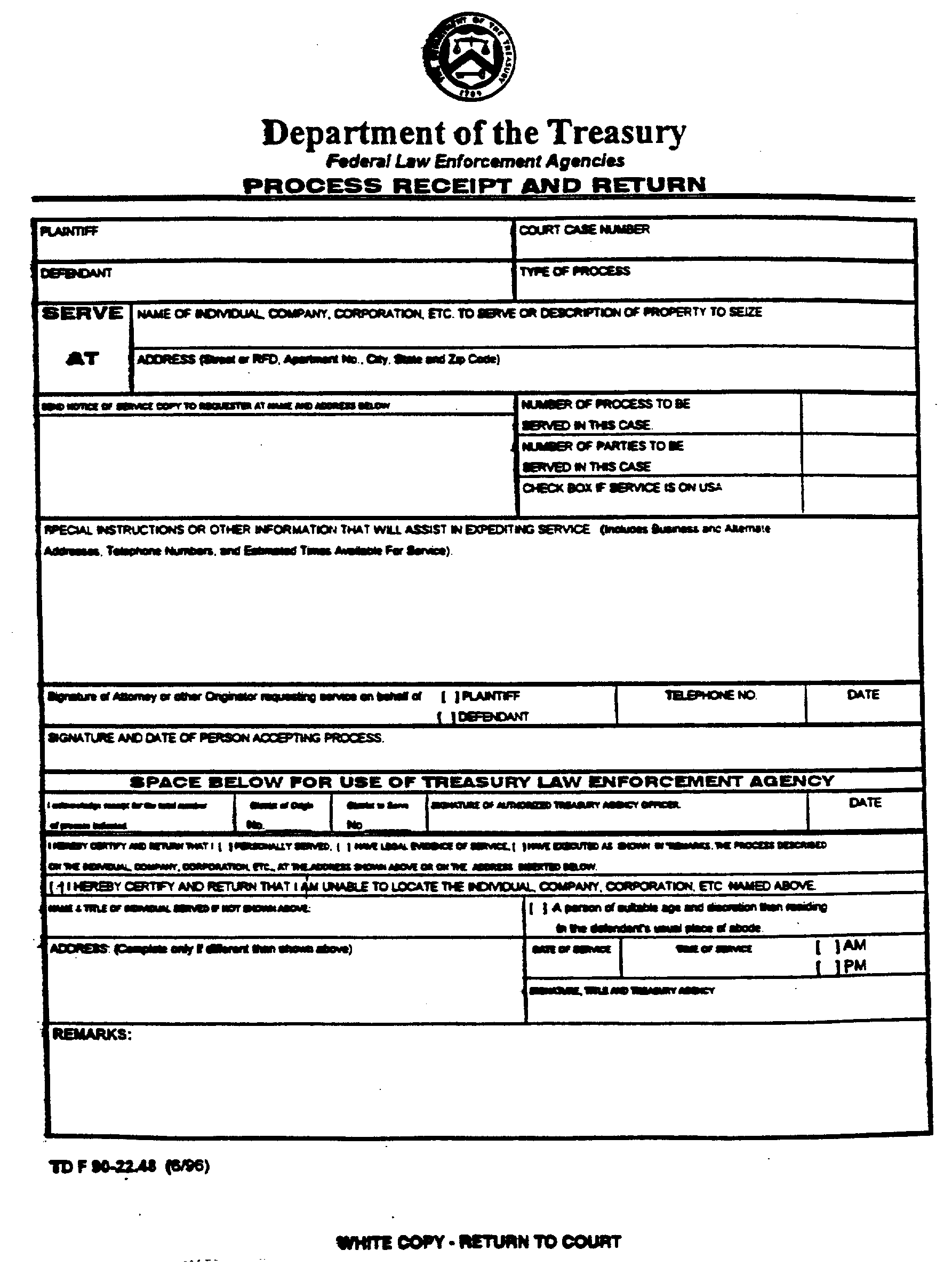
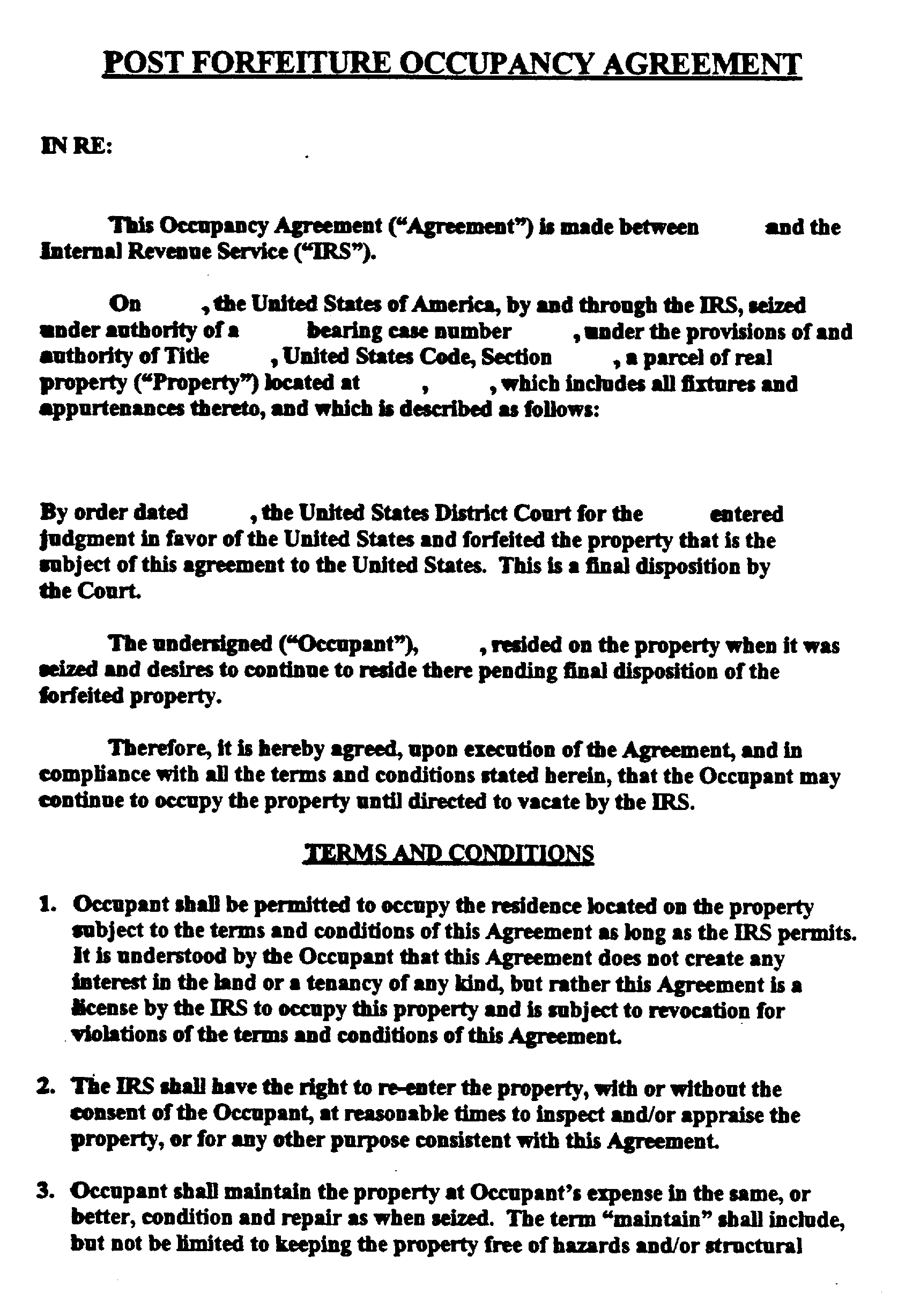
Please click here for the text description of the image.
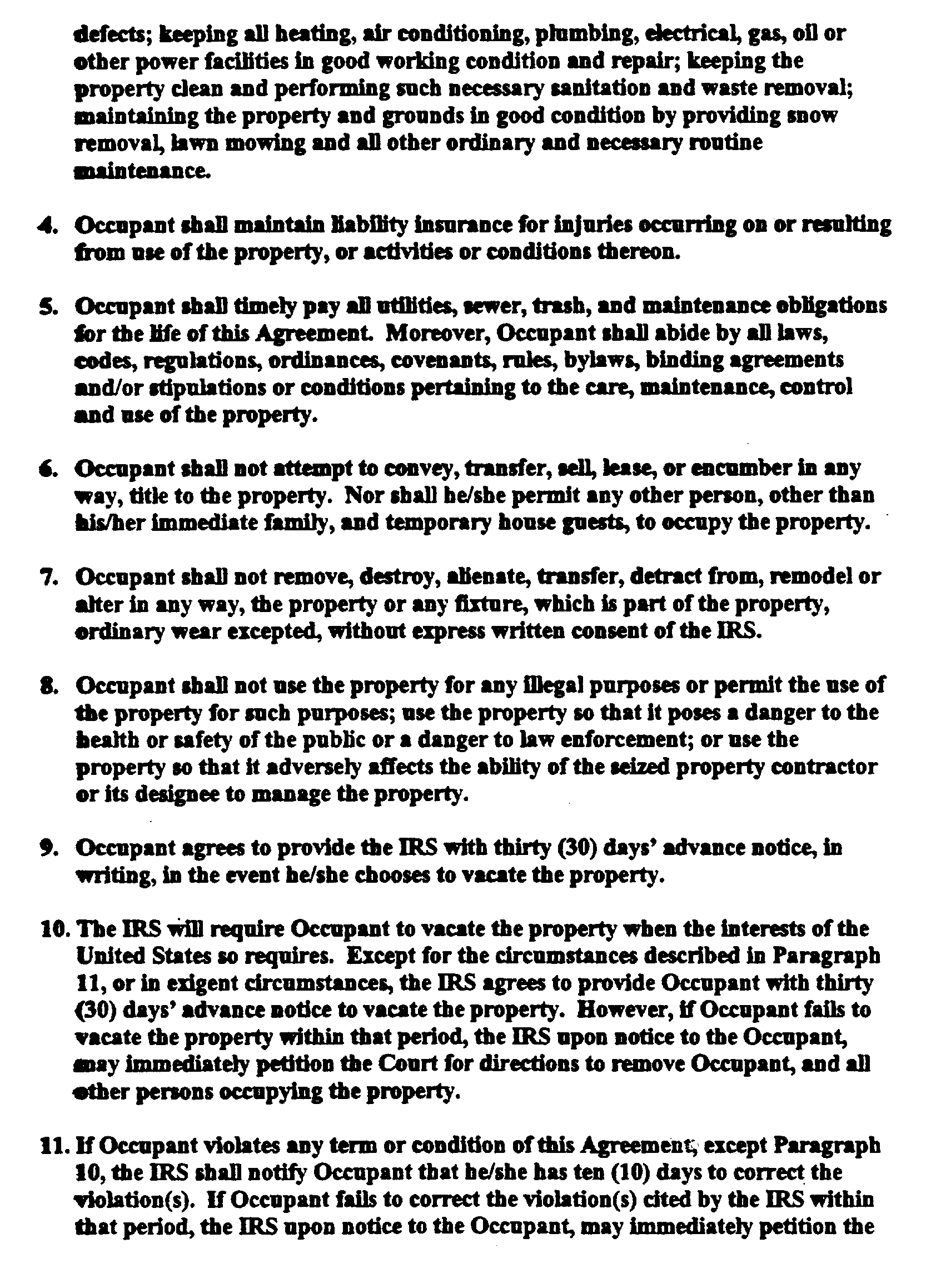
Please click here for the text description of the image.
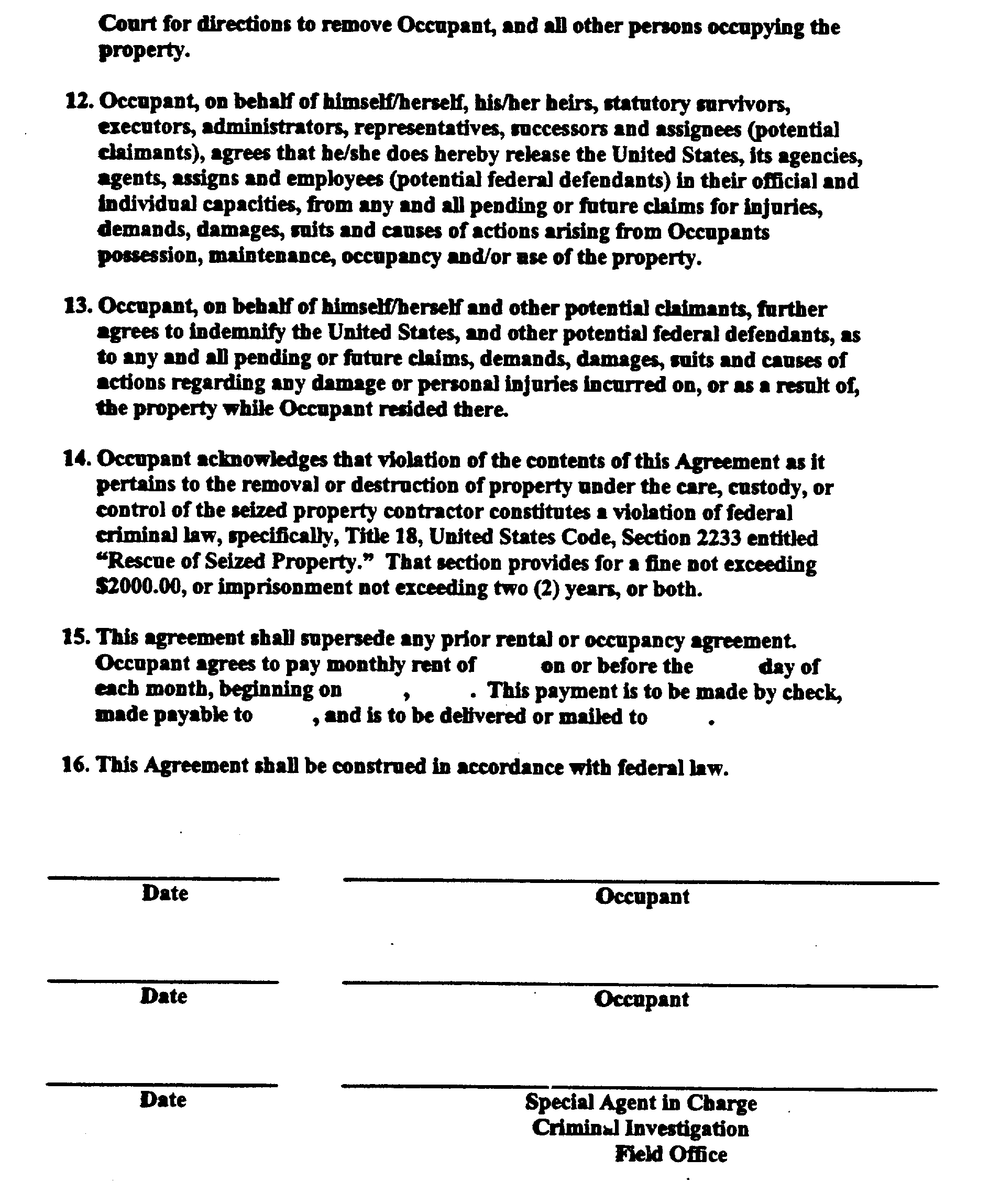
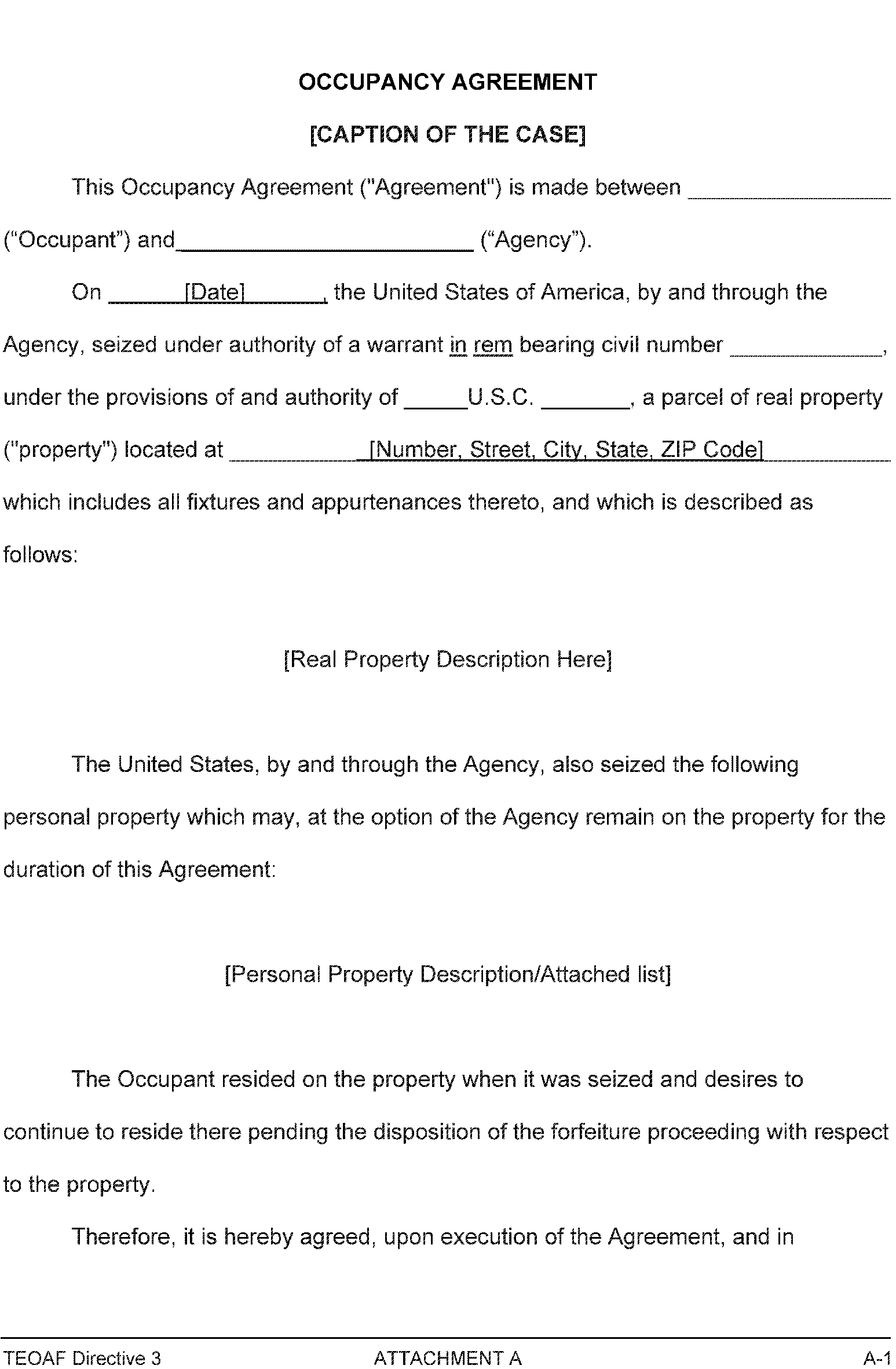
Please click here for the text description of the image.
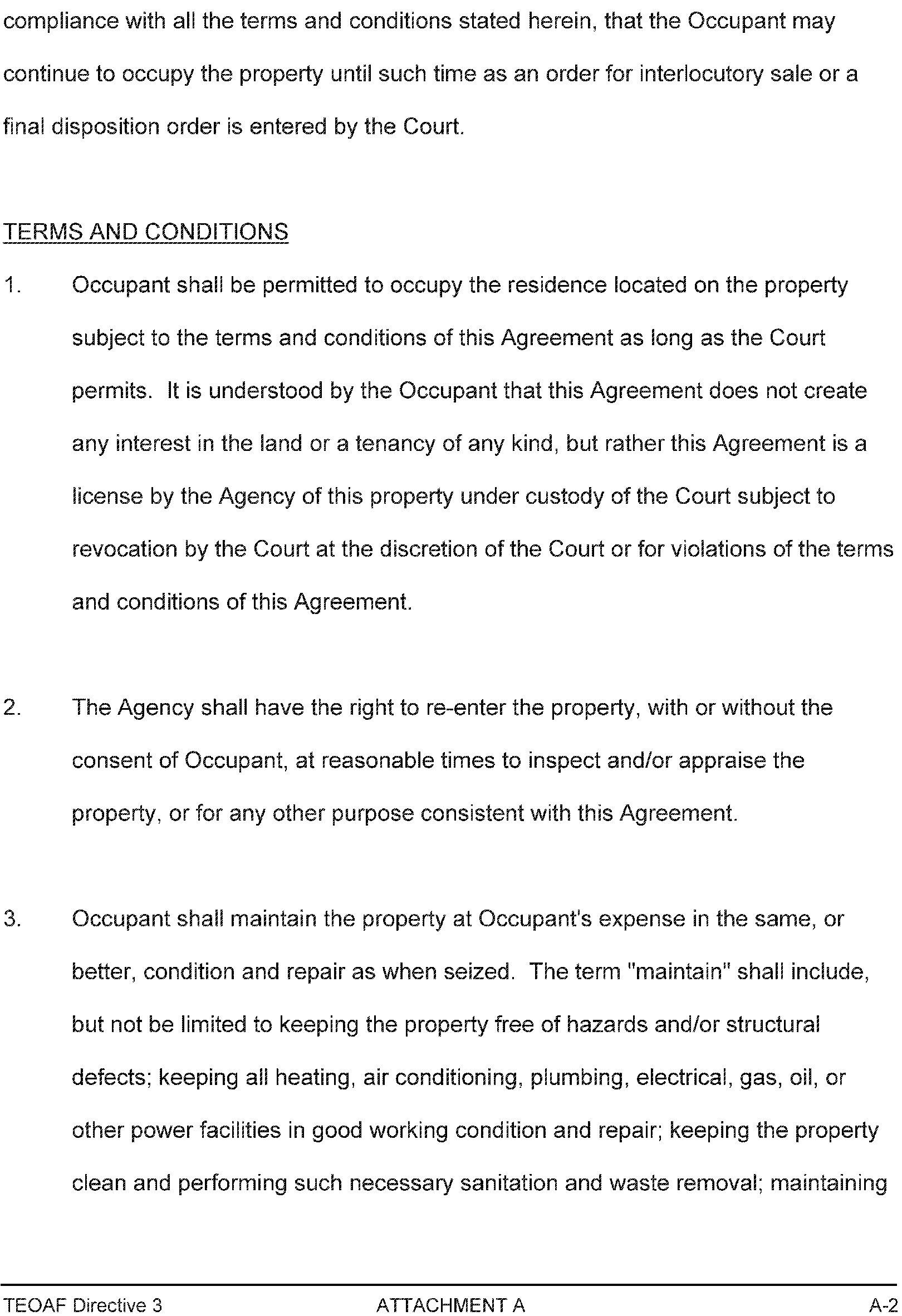
Please click here for the text description of the image.
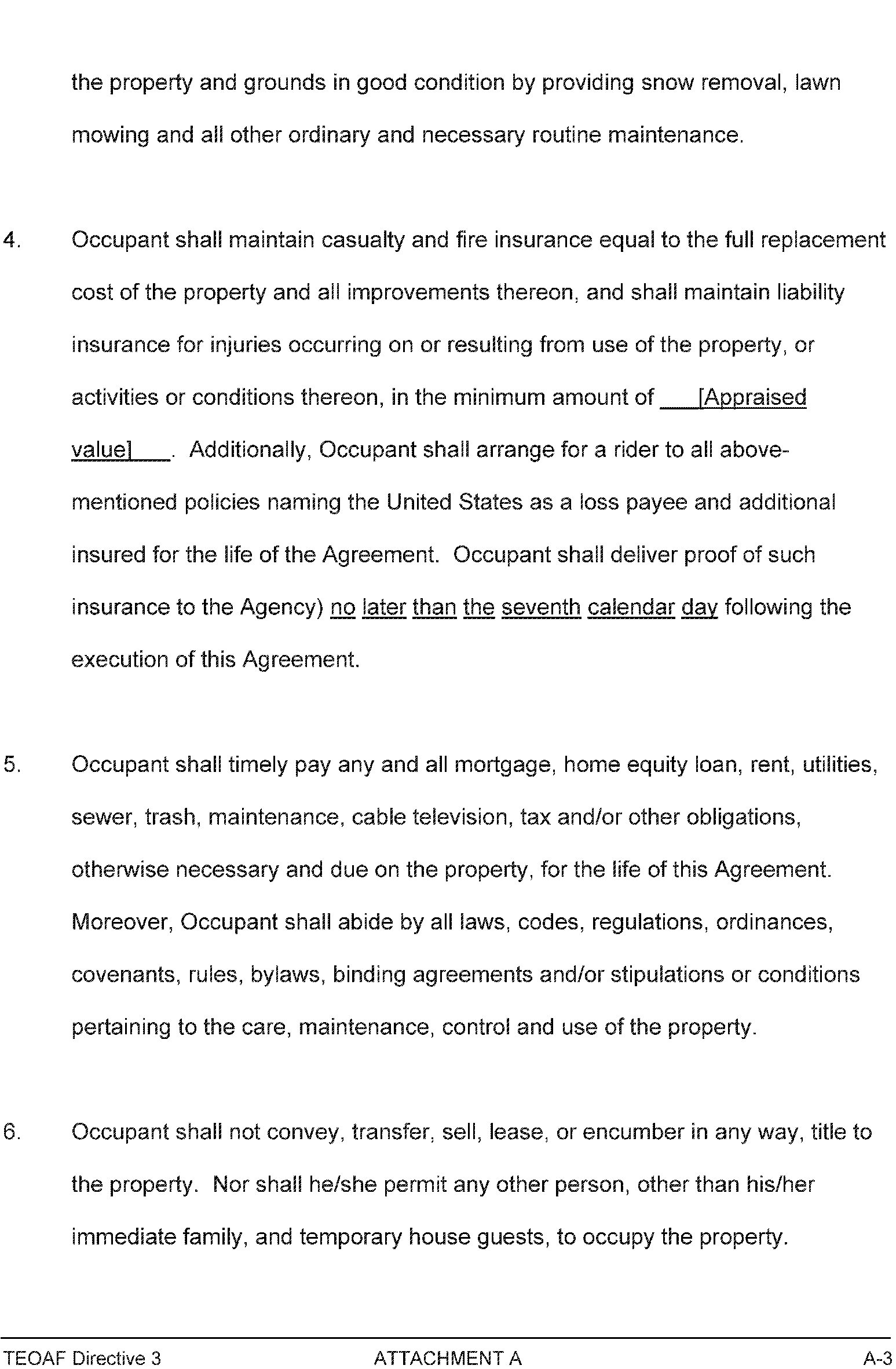
Please click here for the text description of the image.
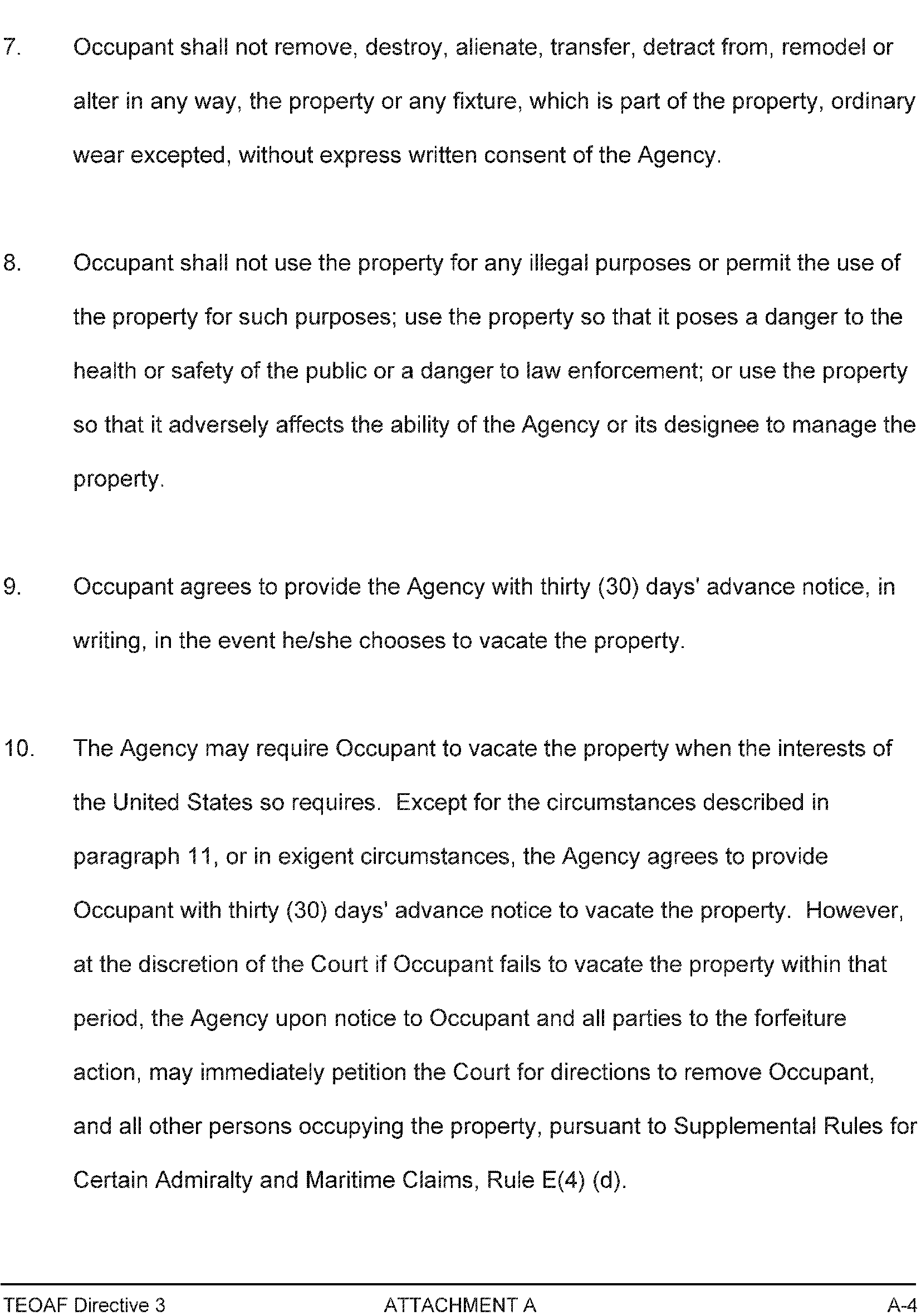
Please click here for the text description of the image.
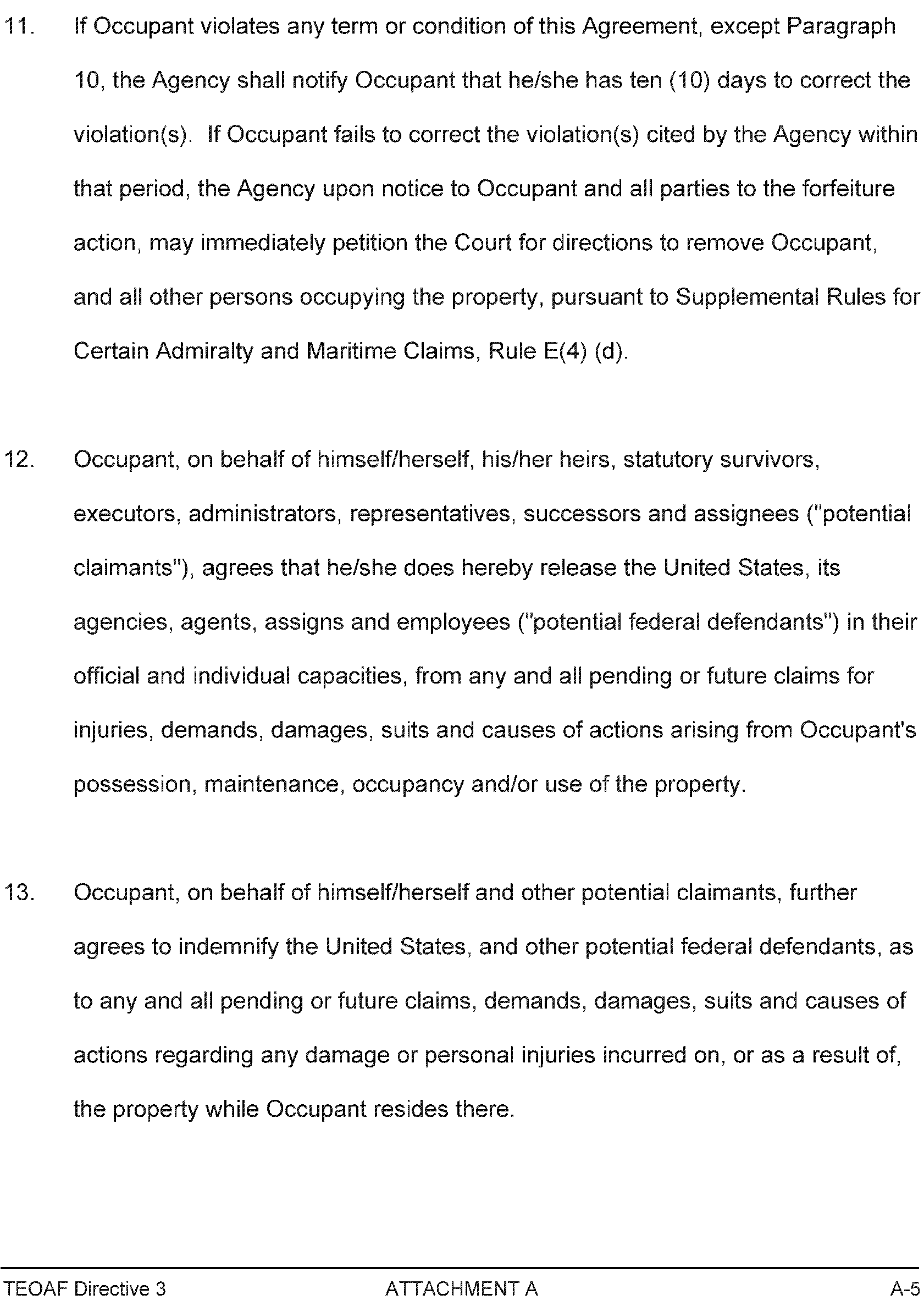
Please click here for the text description of the image.
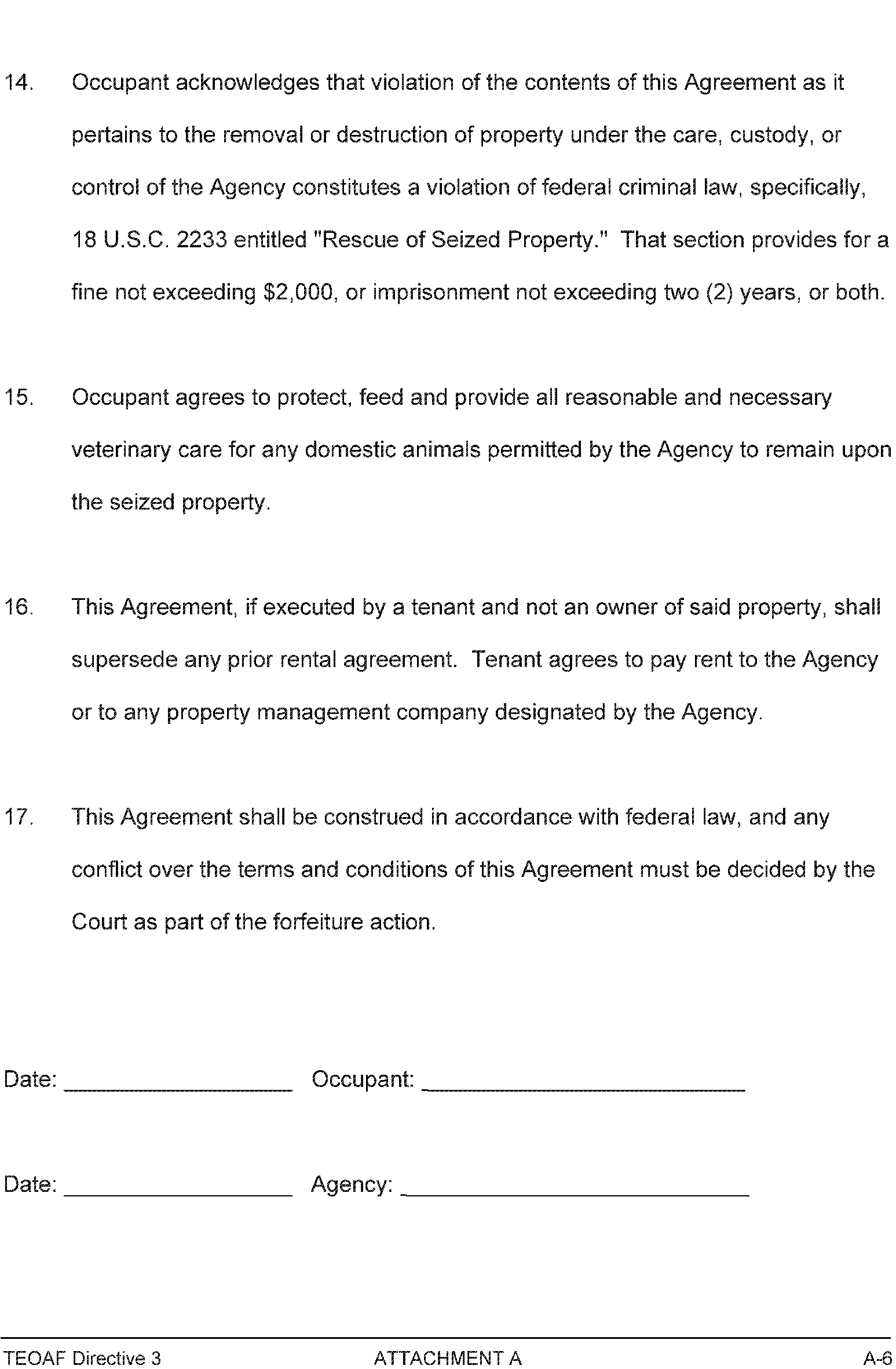
Please click here for the text description of the image.
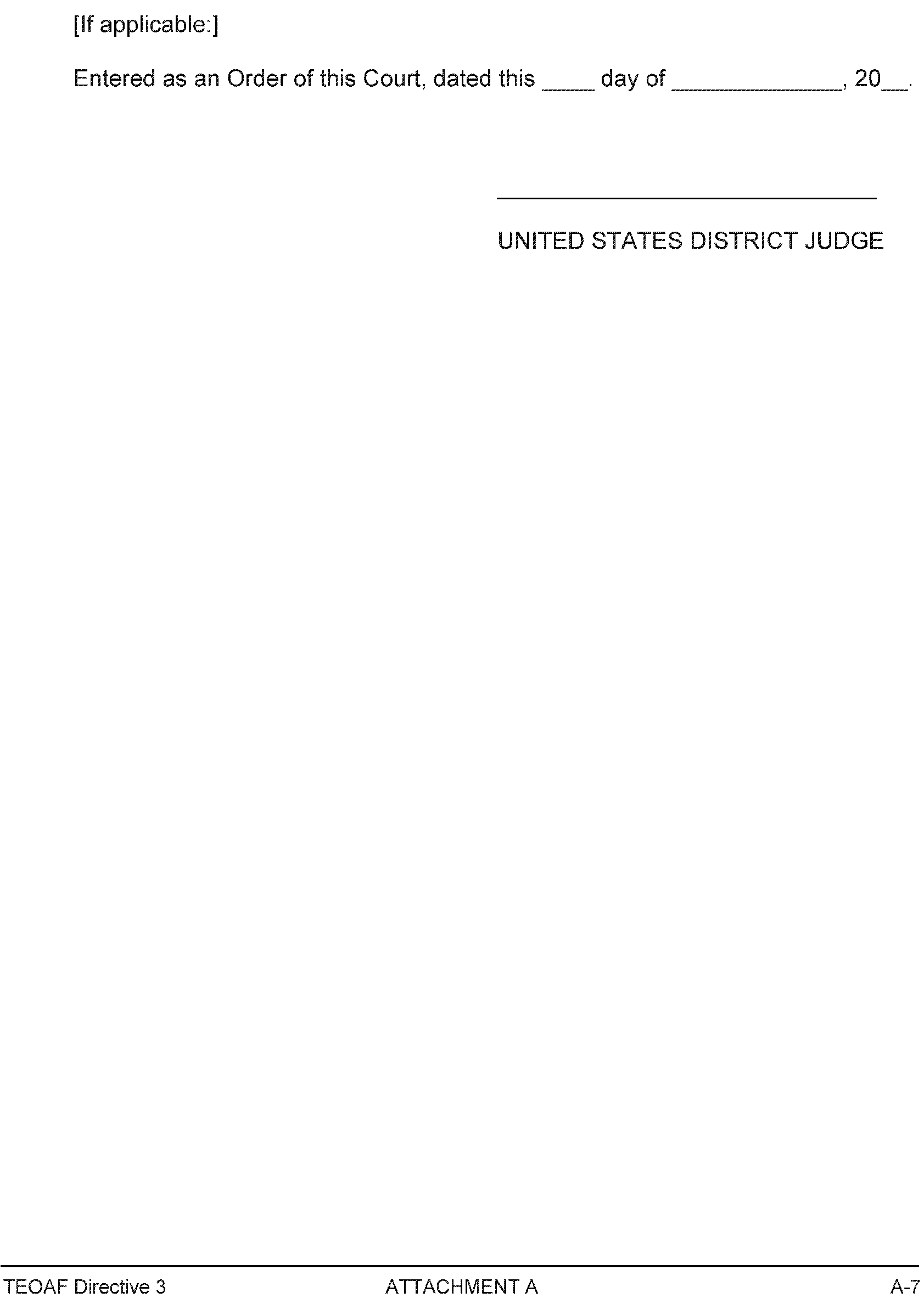
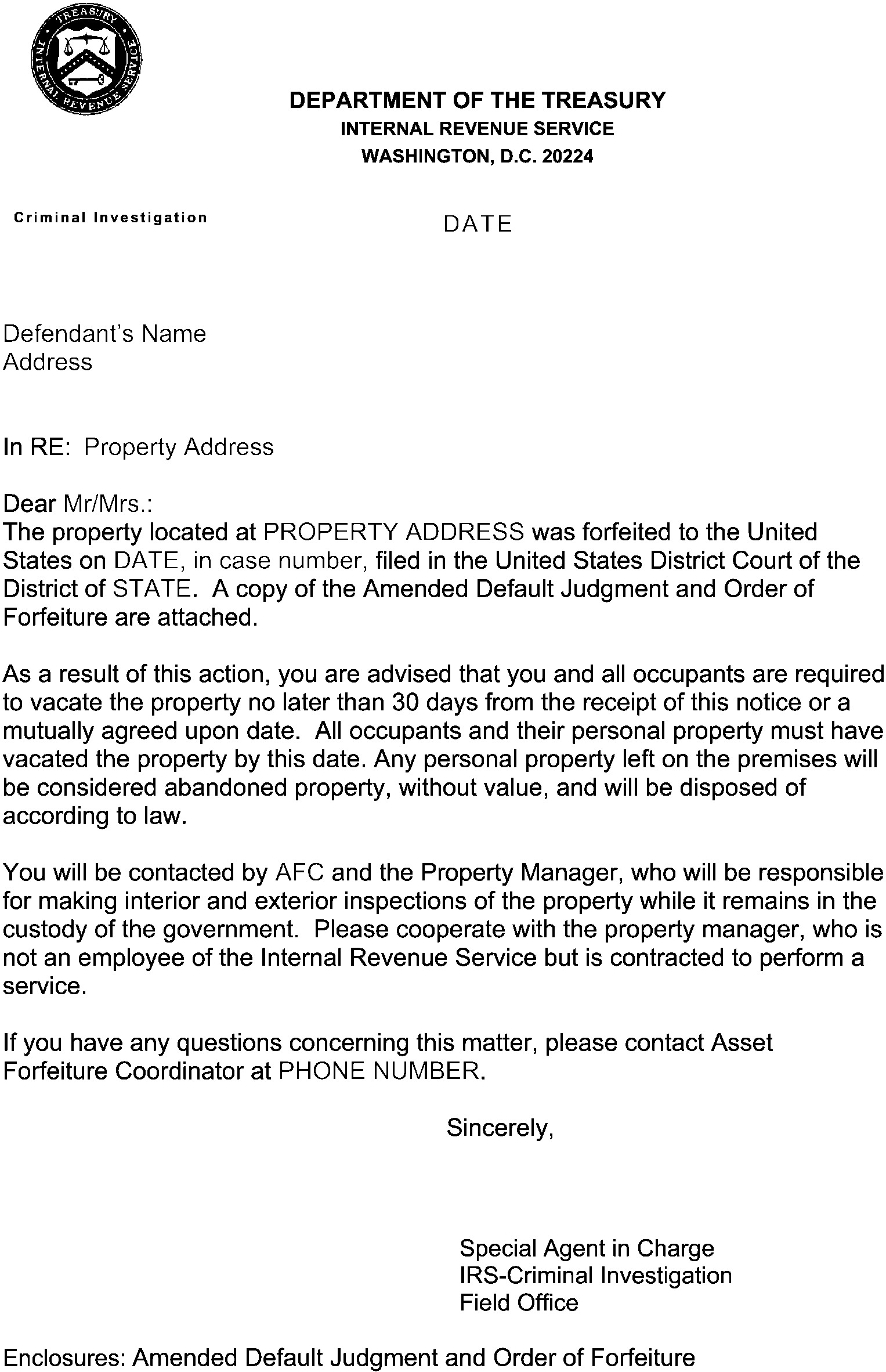
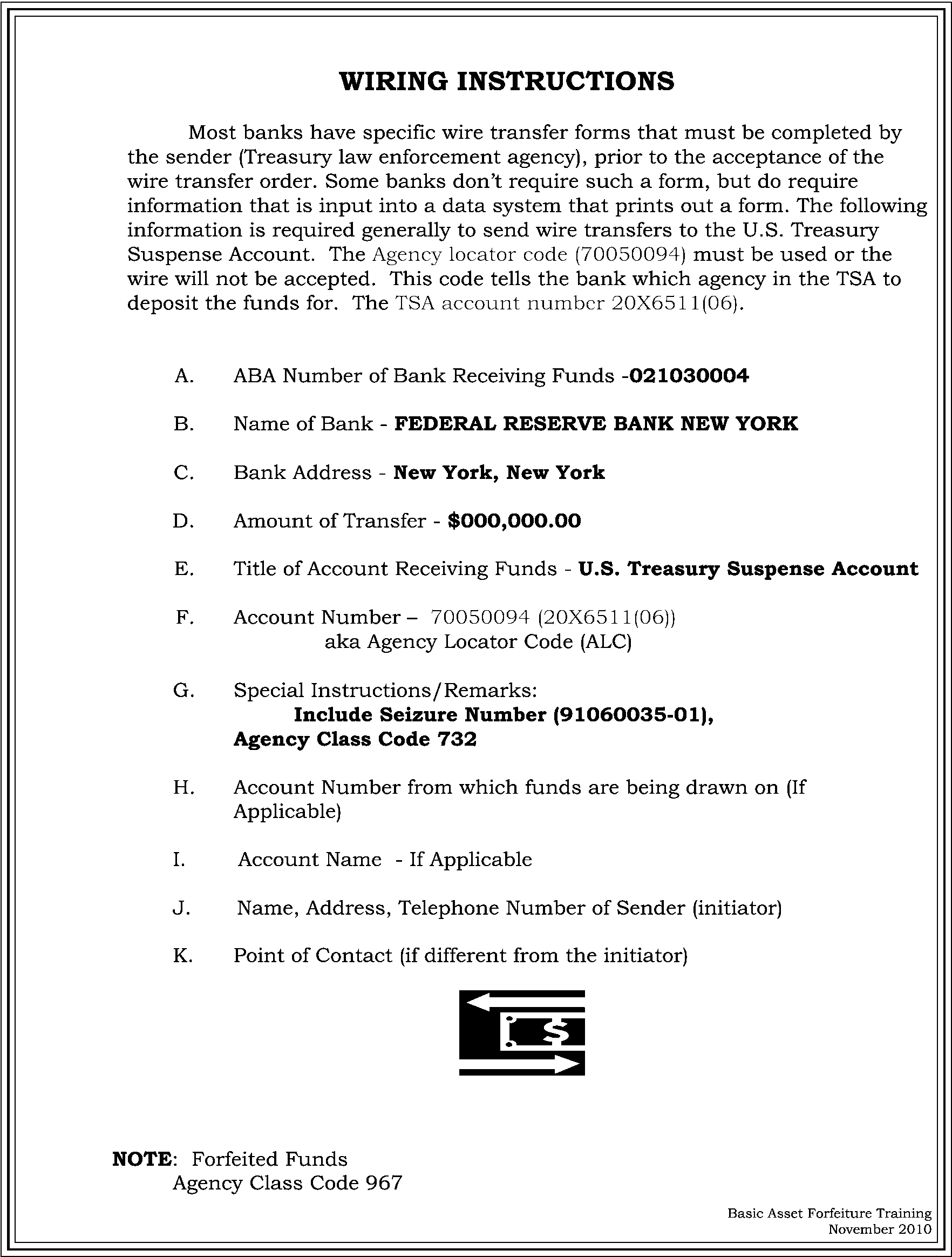
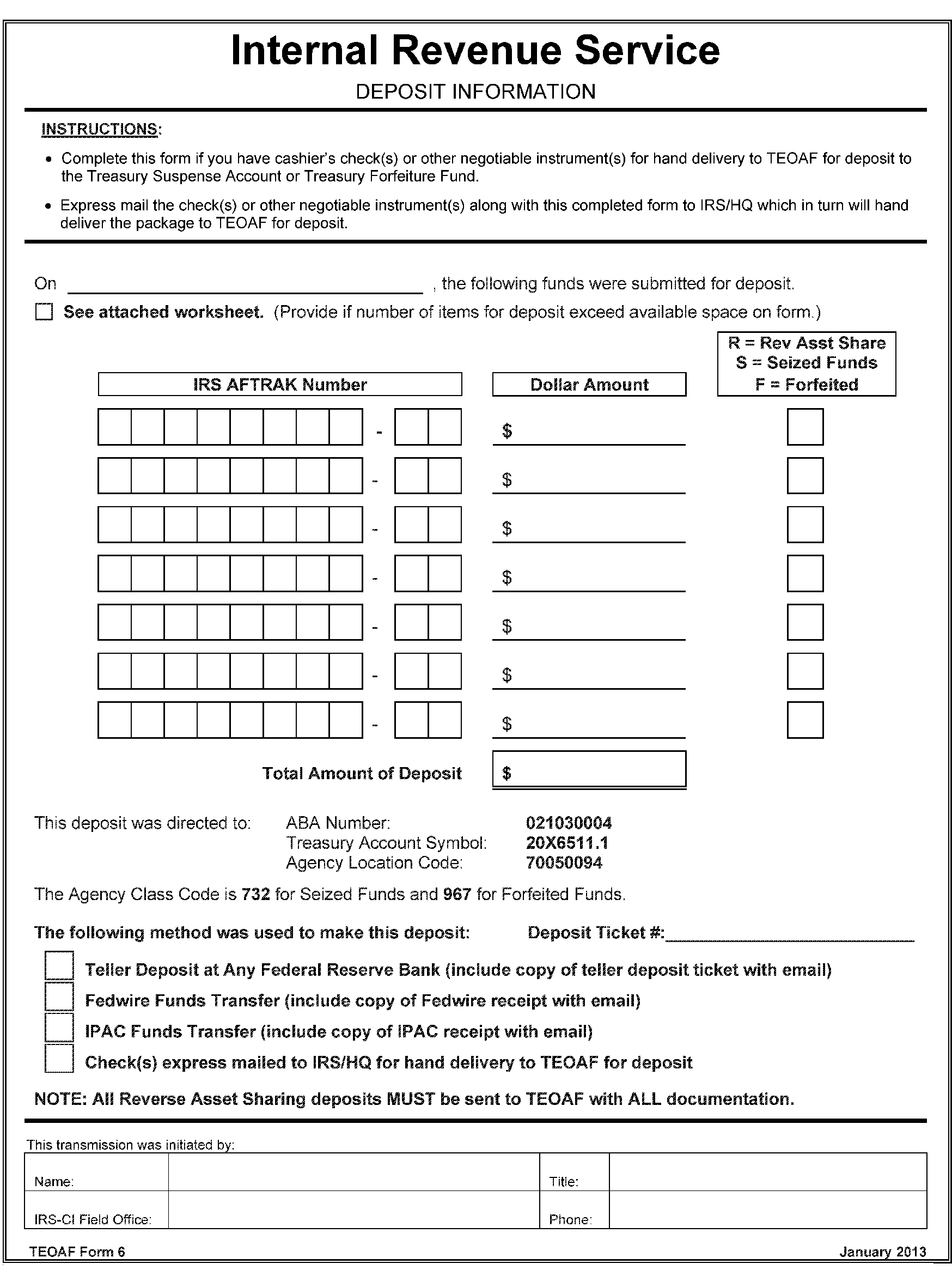

 )
或 https:// 表示您已安全连接到 .gov 网站。仅在官方、安全的网站上共享敏感信息。
)
或 https:// 表示您已安全连接到 .gov 网站。仅在官方、安全的网站上共享敏感信息。

